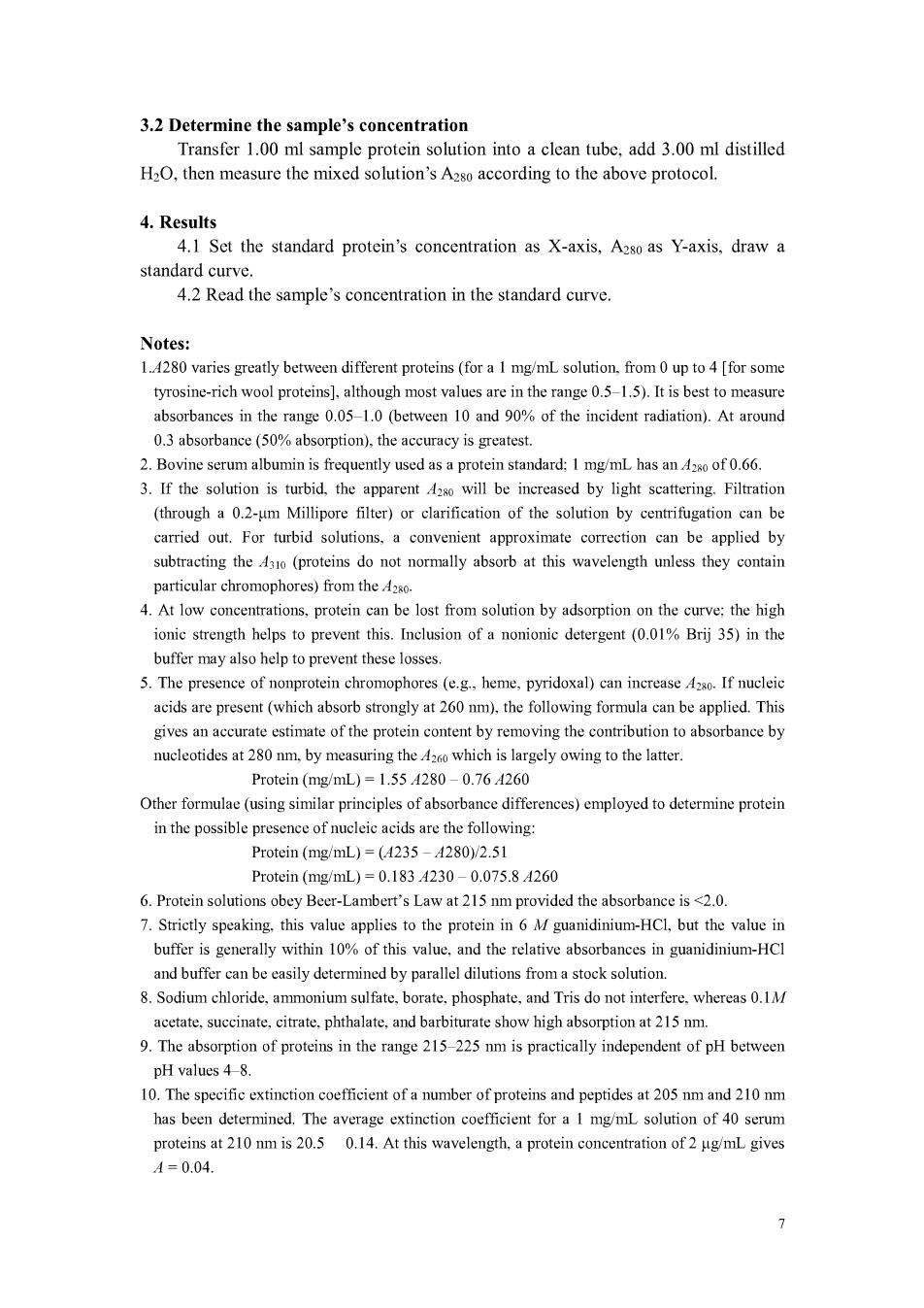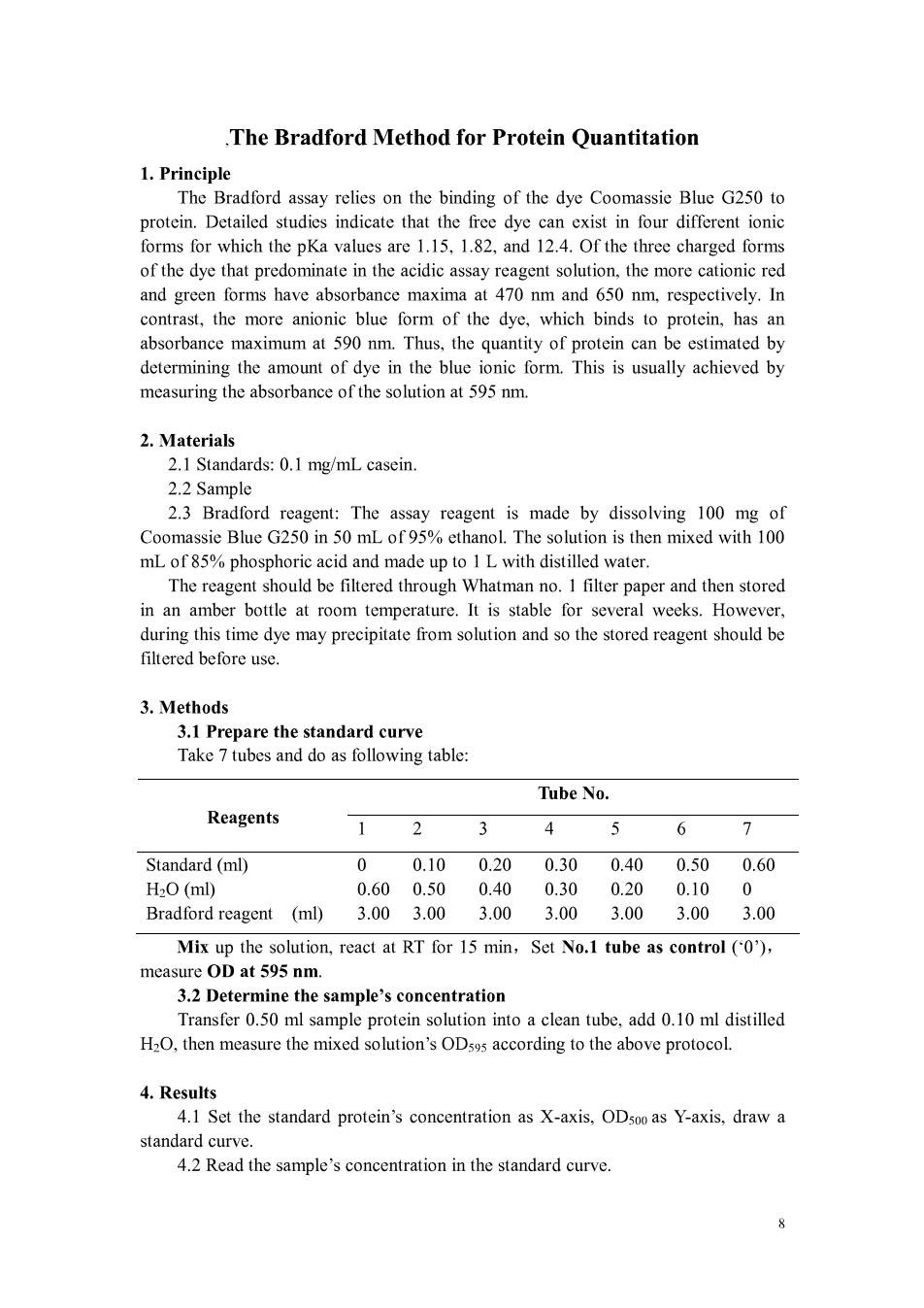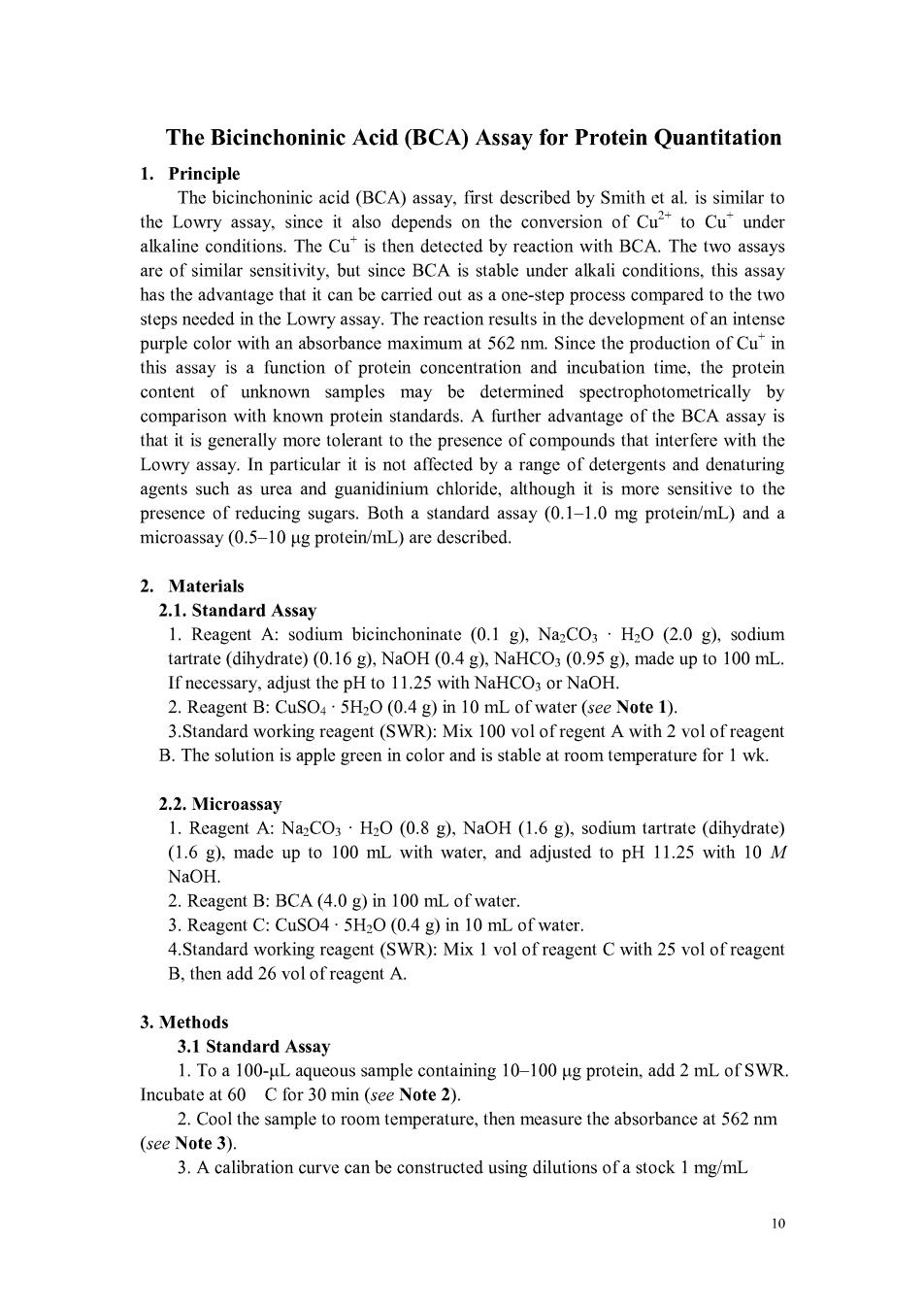
appropriate blank.Interference caused by detergents,sucrose.and EDTA can be eliminated by of precipitation step(sNote 1). 7.The amount of coo produced in this assay by any given protein (or mixture of proteins)is dependent on the amino acid composition of the protein(s)(see Introduction).Therefore,two different proteins.each for example at concentrations of I mg/mL can give different color yields in this assay.It must be appreciated.therefore.that using bovine serum albumin(BSA)(or any eony time when this method gives an absolutealue for protein is when the protein being analyzed is also used to construct the standard curve.The most accurate way to determine the concentration of any protein solution is amino acid analysis. Protein Determination by UV Absorption 1.Principle Protein solutions have a great ultraviolet (UV)absorption at the wavelength of 280nm.Absorption of radiation in the near UV (A28o,or OD2so)by proteins depends on the Tyr and Trp content(and to a very small extent on the amount of Phe and disulfide bonds).So quantitation of the amount of protein in a solution n is possible a simple spectrometer The advantages of this method are that it is simple,and the sample is recoverable. The method has some disadvantages,including interference from other chromophores. and the specific absorption value for a gi ven protein must be determined.The extinctio in the 2-mregio may be as much s 10 times that protein at their same wavelength,and hence,a few percent of nucleic acid can greatly influence the absorption. 2.Materials 2.1.standard protein solution:bovine serum albumin(BSA)solution at 1 mg/ml 2.2 sample (unknown concentration,here we use I mg/ml casein). 2.3 UV-visible spectrometer:The hydrogen lamp should be selected for maximum intensity at the particular wavelength. 3.Methods 3.1 Prepare the standard curve Take 8 tubes and work as the following table: Tube No. Reagents 1 2 3 4 5 6 7 8 Standard(ml) 0 0.50 1.00 1.50 2.002.503.00 4.00 H2O (ml) .003.503.002.502.001.501.00 Concentration(mg/ml)0 0.1250.2500.3750.5000.6250.7501.000 Mix up the reaction system,and measure the A2so with 752-type spectrometer. 6

3.2 Determine the sample's concentration Transfer 1.00 ml sample protein solution into a clean tube,add 3.00 ml distilled HO,then measure the mixed solution's As according to the above protoco 4.Results 4.1 Set the standard protein's concentration as X-axis,Azso as Y-axis,draw a standard curve. 4.2 Read the sample's concentration in the standard curve Notes: 1d280 varies greatly between different proteins (for a I mg/mL solution.from 0 up to 4 [for some tyrosine-rich wool proteins].although most values are in the range 0.5-1.5).It is best to measure absorb ces in th ge 0.05-1.0(between 10 and%of the incident radiation).At aroud 0.3 absorbanc (50%absorption).the accuracy is greatest 2.Bovine serum albumin is frequently used as a protein standard:I mg/mL has an A-8o of 0.66 3.If the solution is turbid.the apparent so will be increased by light scattering.Filtration (through a 0.2-um Millipore filter)or clarification of the solution by centrifugation can be oximate orretion can be applied by at this wave they contain particular chromophores)from the A280 4.At low concentrations,protein can be lost from solution by adsorption on the curve:the high ionic strength helps to prevent this.Inclusion of a nonionic detergent (0.01%Brij35)in the buffer may also help to prevent these losses. 卡i市t2而e il7 hromoph res (e.g.hen se If nucleic gives an accurate estimate of the protein content by removing the contribution to absorbance by nucleotides at 280 nm.by measuring the which is largely owing to the latter Protein (mg/mL)=1.554280-0.76 1260 protein in the posible prese of u ids the followi Protein(mg/mL)=(4235 42802.51 Protein(mg/mL)=0.183A230-0.075.8A260 6.Protein solutions obey Beer-Lambert's Law at 215 nm provided the absorbance is<2.0. 7.Strictly speaking.this value applies to the protein in6M guanidinium-HCl.but the value in buffer is generally within this value. nces in guanidinium-HCl 8.Sodium chloride,ammonium sulfate,borate,phosphate,and Tris do not interfere.whereas 0.1M acetate.succinate.citrate.phthalate.and barbiturate show high absorption at 215 nm. 9.The absorption of proteins in the range 215-225 nm is practically independent of pH between pH values4-8. has been determined.The average extinction coefficient for a I mg/mL solution of 40 serum proteins at 210 nm is 20.5 0.14.At this wavelength.a protein concentration of 2 ug/mL gives A=0.04

.The Bradford Method for Protein Quantitation 1.Principle The Bradford assay relies on the binding of the dye Coomassie Blue G250 to protein.Detailed studies indicate that the free dye can exist in four different ionic forms for which the pKa values are 1.15,1.82,and 12.4.Of the three charged forms of the dye that predominate in the acidic assay reagent solution,the more and green forms have absorbance maxima at 470nm and 650nm respectively.I contrast,the more anionic blue form of the dye,which binds to protein.has an absorbance maximum at 590 nm.Thus,the quantity of protein can be estimated by determining the amount of dye in the blue ionic form.This is usually achieved by measuring the absorbance of the solution at 595 nm. 2.Materials 2.1 Standards:0.I mg/mL casein. 2.2 Sample 2.3 Bradford reagent:The assay reagent is made by dissolving 100 mg of anol The solution is then mixed with 100 mLof85%phosphorieacidandmadeupto1Lwithdistilcdwalcr The reagent should be filtered through Whatman no.1 filter paper and then stored in an amber bottle at room temperature.It is stable for several weeks.However, during this time dye may precipitate from solution and so the stored reagent should be filtered before use 3.Methods 3.1 Prepare the standard curve Take 7 tubes and do as following table: Tube No. Reagents 1 2 3 5 6 7 Standard(ml) 0 0.100.200.300.400.500.60 H-O (ml) 060050 040 030020 0.100 Bradford reagent (ml) 3.003.00 3.00 3.00300 3.00300 Mix up the solution,react at RT for 15 min,Set No.1 tube as control () measure ODat 595nm 3.2 Determine the sample's concentration Transfer 0.50 ml sample protein solution into a clean tube,add 0.10 ml distilled H2O,then measure the mixed solution's ODs9s according to the above protocol. 4.Results 4.1 Set the standard protein's concentration as X-axis,ODsoo as Y-axis,draw a standard curve. 4.2 Read the sample's concentration in the standard curve

Notes: 1.A rapid and accurate method for the stimation of protein is essential in many fields of protein study.n assay originally deseribed by Bradford has become the preferre method for quantifying protein in many laboratories.This technique is simpler.faster.and more sensitive than the Lowry method.Moreover,when compared with the Lowry method,it is subject to less interference by common reagents and nonprotein components of biological samples. on the Bradford Assa Absorbance at 600 nm Compound Blank Control 0.00 0.26 0.029%sD5 0.003 0.250 0 1%6SDS 0042 0059: 0.1%Triton 0.000 0278 0.051 031E I M 2-Mercaptoethanol 0.00 0.27 1 M Sucrose 0.008 0.261 4 M Urea 0.008 0261 4MNaCl 0.015 0.207: 0014 023% 0.1 M HEPES.PH7.0 0.00 0 0.I M Tris.pH 7.5 0.00 0.261 0.1 M Citrate,pH 5.0 0.015 0.249 10 mM EDTA 0007 0215 1 M (NH4)2504 0.002 026 Data were obtained by mixingofsampewith5ofthe speeified compound efre adding00ofdye "Measurements that differ from the control by more than 0.02 absorbance unit for blank values or more than 10% 2.Binding of protein to Coomassie Blue G250 may shift the absorbance maximum of the blue ionic form of the dye from 590 nm to 620 nm.It might,therefore,appear more sensible to measure the absorbance at the higher wavelength.However.at the usual pH of the assay.an appreciable proportion of the dye is in the green form()which interferes with dye-protein compl 620 nm.Mea 505 represents the best compromise between maximizing the absorbence due to the dye-protein complex while minimizing that due to the green form of the free dye 3.The dye does not bind to free arginine or lysine.or to peptides smaller than about 3000 Da Many peptide hormones and other import bioctive peptides fall into the atter category,and the Bradford assay is not suitable for quantifying the amounts of such compounds

The Bicinchoninic Acid(BCA)Assay for Protein Quantitation 1.Principle The bicinchoninic acid (BCA)assay,first described by Smith et al is similar to the Lowry assay,since it also depends on the conversion of Cu to Cu"under alkaline conditions.The Cu'is then detected by reaction with BCA.The two assays are of similar sensitivity,but since BCA is stable under alkali conditions.this assay steps needed in the Lowry assay.The reaction results in the development of an intense purple color with an absorbance maximum at 562 nm.Since the production of Cu"in this assay is a function of protein concentration and incubation time,the protein content of unknown samples may be determined spectrophotometrically by c rison with known protein standards.A further of the BCA a that it is generally more tolerant to the presence of compounds that interfere with the Lowry assay.In particular it is not affected by a range of detergents and denaturing agents such as urea and guanidinium chloride,although it is more sensitive to the of reducing sugars.Both a standard assay (0.1-1.0 mg protein/mL) ssay(0.5-10 ug protein/mL)are descr ribed 2.Materials 2.1.Standard Assay 1.Reagent A:sodium bicinchoninate (0.1 g).NazCOH2O(2.0 g).sodium tartrate (dihydrate)(0.16 g).NaOH (0.4 g).NaHCO3(0.95 g).made up to 100 mL. If necessary,adjust the pH 11.25 with NaHCO,or NaOH. 2.Reagent B:CuSO5H2O(0.4 g)in 10 mL of water (see Note 1). 3.Standard working reagent(SWR):Mix 100 vol of regent A with 2 vol of reagent B.The solution is apple green in color and is stable at room temperature for I wk. 2.2.Microassay 1.Reagent A:(0.8 g).NaOH(1.6 g),sodium tartrate (dihydrate) (1.6 g),made up to 100 mL with water,and adjusted to pH 11.25 with 10 M NaOH 2.Reagent B:BCA(4.0 g)in 100 mL of water 4.Standard w B.then add 26 vol of reagent A. 3.Methods 3.1 Standard Assav 1.To a 100-uL aqueous sample econtaining 10-100 ug protein,add 2 mL of SWR Incubate at 60 C for 30 min (see Note 2). 2.Cool the sample to room temperature,then measure the absorbance at 562 nm (see Note 3). 3.A calibration curve can be constructed using dilutions ofa stock 1 mg/mL